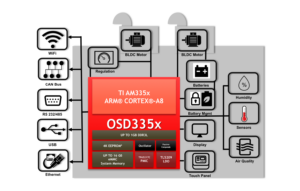Related Products
Industrial HVAC Controller System in Package Based on AM335x
Published On: July, 3, 2019 By: Jennifer Hellar | Updated: September 2, 2019 by Cathleen Wicks
 Better control of Heating, Ventilation, and Air Conditioning (HVAC) has been a focus for building operators since the first units were installed. Today, HVAC accounts for a significant portion of the electricity cost of a building with some estimates putting it as high as 40%. More efficiently controlling the HVAC system consistently leads to significant savings.
Better control of Heating, Ventilation, and Air Conditioning (HVAC) has been a focus for building operators since the first units were installed. Today, HVAC accounts for a significant portion of the electricity cost of a building with some estimates putting it as high as 40%. More efficiently controlling the HVAC system consistently leads to significant savings.
Typically, HVAC systems are managed by a central smart controller that takes in measurements (temperature, humidity, air quality, etc.) from around the building and then controls the different aspects of the HVAC system (Heaters, Chillers, Pumps, Fans, Valves). It runs an operating system like Linux and executes different applications that can be programmed by the building operator. The central controller manages hundreds of different HVAC system components depending on the size of the building. Due to the number of components in a building the edge controllers are often low cost devices that can be turned on or off. Current edge controllers therefore lack the processing power to do finer control. From discussions with our customers, it is clear that there is a move in the industry to add more processing power to these edge components of the HVAC system to give them better control and better efficiency.
We recently worked with one of our customers to create a complete reference design for an edge node HVAC controller featuring the OSD335x C-SiP. Using the C-SiP, a complete AM335x System in Package, in HVAC system components enables them to run much more complicated control programs without adding significant cost. The OSD335x C-SiP is a complete embedded Linux Computer in a single IC giving the system components the same class of computational power as the central controller. This new capability empowers the components to have finer control, allowing for optimized use and better efficiency. System nodes can also monitor their own performance and alert operators when things aren’t running at peak efficiency.
The OSD335x C-SiP integrates a 1GHz ARM Processor, DDR Memory, Power, eMMC, and passives in a single device so the same low cost manufacturing process and PCB design can be used. There is no need for a daughter card to support complex PCB processors that aren’t compatible with the rest of the system. The OSD335x C-SiP is the perfect way to add significant processing power to a low cost system
A PDF version of this Application Note can be downloaded HERE.
Powerful ARM Processor
The ARM Corex-A8 AM335x processor running up to 1GHz from Texas Instruments in the OSD335x family enables the features needed in any controller system. It provides enough performance to run analytics locally providing real-time actionable data to optimize the HVAC system, like shutting down units in empty rooms or reporting malfunctioning units.
Interfaces
The OSD335x C-SiP has numerous interfaces like UART, SPI, I2C, and GPIO to connect to any required sensor such as temperature/humidity or air quality. It can support long-range RS-485 communication and has two CAN interfaces to easily communicate with local devices and provide real-time control. The Controller Reference Design App Note describes how to implement these interfaces. Leverage the large Open Source Community to quickly implement your solution.
Connectivity
Whether it be Cellular, Satellite, Bluetooth, Wi-Fi, USB, Ethernet, or some other communication protocol, you need to get your data to be analyzed somewhere. The OSD335x family easily supports them all.
Performance Analytics
The OSD335x is capable of fast data acquisition and data analytics with support for R, Python, SaS, SQL, and many other languages. Applications that generate useful performance data and insights can be developed.
Secure
The data collected is valuable and needs to be protected. The OSD335x includes hardware accelerators for AES, SHA, and random number generation enabling the encryption of the collected data for storage and transmission to the remote data center. It easily connects to a device like a Trusted Platform Module (TPM) and provides Secure Boot, making sure the software running on the device has not been compromised.
Real Time Control
The OSD335x also integrates 2 Programmable Real-time-Units (PRUs) for real time motor control and custom applications. These 200 MHz microcontrollers provide real-time, high throughput custom control and feedback data processing.
Full Linux Support
Leverage the breadth of the Linux community to quickly get your system running. No need to write drivers for different sensors or handle complex networking stacks, let Linux handle it for you. The OSD335x is completely supported in mainline Linux.
Robust Solutions
The OSD335x C-SiP is built to work in the harshest environments. It is rated to work in temperatures ranging from -40°C to 85°C. Also its plastic encapsulated mold makes it able to withstand the highest vibration environments.
Faster Time to Market
The OSD335x makes designing with a powerful ARM Cortex-A8 processor as easy as working with a Microcontroller. Spend less time on getting the processor to work and more time focusing on developing your product.
Get Started Today
Begin developing today. There are a number of open source development platforms available. We recommend looking at the BeagleBoard.org® BeagleBone® Blue and OSD3358-SM-RED as starting points for HVAC controllers. We also highly recommend this Building Automation System Controller Reference Design App Note written by industry specialist Calvin Slater.